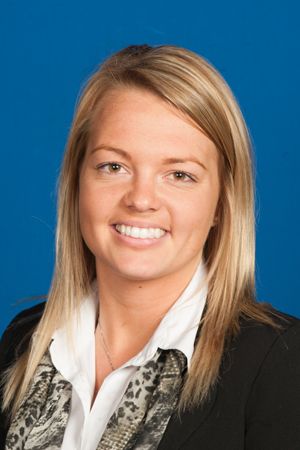By Sara Palmer

Emma Campbell ’13
What do Condoleezza Rice, Johnny Carson, Harrison Ford, and Donald Trump have in common? Here’s a hint: more than seven U.S. presidents also share this trait. Astronaut John Glenn has it, along with the current and former CEOs of Disney, LinkedIn, Sony, General Electric, Southwest Airlines, Wikipedia and Rubbermaid. Three Nobel Prize winners in chemistry and at least one member from the 1960s band “The Monkees” have it, too.
All of these talented, successful, interesting individuals have one major thing in common – they all have a liberal arts education.
“I think all liberal arts students carry a little something extra with them,” said Janet Clark, Ph.D., vice president for academic affairs at Saint Mary-of-the-Woods College (SMWC). “Liberal arts graduates bring their whole selves to their careers. They don’t just excel in the technical side or the area related to their discipline. They come in with a broader way of thinking and working.”
A liberal arts curriculum doesn’t just churn out graduates with one tool in the box. It combines broad knowledge of the wider world with the in-depth study of a specific area of interest. These graduates become top tier talent in their fields because they are taught how to think, not what to think
“Even though I was a psychology major, I was able to branch out quite a bit at SMWC,” said Emma Campbell, prevention specialist at the Human Resources Center of Edgar and Clark Counties. “For example, I took several journalism and media classes, and even joined the school newspaper, despite not having either as a major or a minor.” She paused. “When a need came about for graphic design work at my social services job, I was the only person in my company who had a background in graphic design.”
Campbell graduated from SMWC in 2013 and harnesses her liberal arts degree to prevent substance abuse and teach awareness to at-risk youth in Indiana. Her education helps her solve problems by coming at one situation from multiple angles. By thinking critically and analytically about issues facing the community, Campbell not only made an impact on those who receive these services, but on the organization, as well. She’s used her education and experience from extracurricular activities to enhance their mission with event planning, public speaking, networking and engaging with the media. “That’s what liberal arts means to me,” she said, “you develop this wide variety of skills that are a benefit to both you and society.”
Benefitting the greater good is the cornerstone to a liberal arts education. It isn’t just about climbing a corporate ladder; it’s about being part of a team and contributing to something larger than yourself. 2011 SMWC graduate Erin Pugh, director of special projects for Indiana Congressman Larry Bucshon, feels that way every day.
“Being a public servant isn’t always easy,” Pugh explained, “but I cannot imagine myself in a role that doesn’t involve helping others in a positive way, big or small. I feel privileged to help someone fill out social security forms or coordinate a job fair that connects an employee to meaningful work.”

Erin Pugh ’11
After SMWC, Pugh went immediately into an MBA program and remembers her first day of classes with a wistful smile. “The professor just dove right into the lecture. The other students looked so lost. I raised my hand to ask a clarifying question and afterwards I had fellow students walk up to me and thank me for breaking the ice. They just didn’t feel as comfortable asking questions as I did.”
A liberal arts education, especially in a single-gender environment like SMWC, is known for building the kind of confidence that empowers people. These students learn to be responsible for their own future. They don’t rely on the world to hand success to them; they want to earn it. They aren’t afraid to ask questions or even ask for help, if that’s what it takes to get a project completed right and on time. With their liberal arts education, these are the kinds of professionals who appreciate collaboration, but can also work autonomously. More importantly, they know how to tell the difference. They know when a situation requires cohesive teamwork and when it’s time to mount up and tackle a problem head on.
“We are training students for jobs that haven’t even been created yet,” Clark said. “Yes, SMWC graduates give employers top tier work through well-developed communication and problem-solving skills, typical of traditional liberal arts programs. However, they also bring empathy, compassion, open-mindedness and an awareness of social justice to their careers and communities.”
At SMWC, students are encouraged to explore and discover, so, as employees, it is only natural that they can adapt easily to the complexity of a changing workplace. With their foundation in critical thinking and communication, liberal arts graduates become employees who see solutions that address the bigger picture. They seize opportunities, like Campbell, who not only works to prevent substance abuse in teens, but also writes press releases and social media posts for her company. Similarly, Pugh isn’t afraid of change. She wants to keep growing professionally and personally. She isn’t the only one. These are qualities that liberal arts instills in many of its students.
“I think as along as I keep moving forward, I am succeeding,” said Margy Frazier, a 2014 SMWC graduate with a degree in equine business management. “I think the fact that I am still learning and still growing means that I am succeeding every single day.”
What company wouldn’t want an employee with that kind of passion and drive? That’s why so many liberal arts graduates rise to the top of their fields. And, contrary to the stereotypes, those fields aren’t always artistic. Liberal arts doesn’t just mean music, art, theatre or philosophy. It also doesn’t just mean an education filled only with science and math, either. These graduates are successful because it never has to be one or the other.
Take, for example, the music technology lab at SMWC. Students walk into a brightly colored room filled with Apple computers, keyboards and recording equipment. In 2012, the College received a substantial grant from the Westerman Foundation that put cutting-edge computer technology in the middle of a 100-year-old music conservatory.
“We intentionally create programs and courses that allow our students to become dynamic leaders and critical thinkers,” Clark said. “Liberal arts students are problem-solvers because they are exposed to opportunities that build specific skills, while opening the mind.”
When Frazier first arrived at SMWC, she was set on a career with horses. Now she’s a graduate student, working on her master’s in student affairs and higher education. “Before coming to SMWC, I was shy and quiet,” she said. “But my liberal arts education shaped me into someone willing to step out of her comfort zone and explore every opportunity to grow.”
Continuously growing and learning are qualities Frazier, Pugh and Campbell all value. Filled with potential, they all see themselves as successful, even though they are all just starting out in the post-college world. This is because, in part, they all agree on a very special definition of success.
“Success isn’t about how much money you make or what type of car you drive or how big your house is,” Pugh said. “I measure success by my happiness in what I’m doing.”
A liberal arts education creates top tier talent by instilling in its graduates the idea that success comes from having joy in what you do and using your talents to change the world, to make a difference, big or small.
“I don’t make a lot of money and my job doesn’t come with a lot of prestige, but I can see the work I do benefit those in the community,” Campbell said. “For that, I count myself among the successful.”